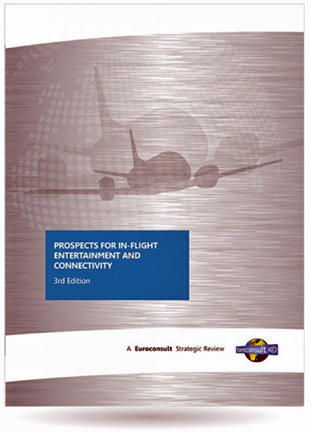
[SatNews] According to Euroconsult's newly released report, Prospects for In-Flight Entertainment and Connectivity, the global in-flight connectivity market is expected to grow over the next 10 years, with over 12,900 commercial and 24,000 business aircraft providing in-flight connectivity to passengers by 2023.

Along with the growth in installation, both the take-up rate and ARPU are expected to improve. As a consequence, total revenue from passenger connectivity services is expected to grow from $440 million in 2013 to $2.1 billion by 2023.
"At present, 59 airlines provide passenger in-flight connectivity services via satellite or ATG networks. Over 80 percent of connected aircraft are still from North America; however, Europe, the Middle East and Asia are gaining importance in the market, and are expected to be the major growth engines in the next decade," said Wei Li, Senior Consultant at Euroconsult and Editor-in-Chief of the report. "Despite the highly competitive nature of the existing market, new entrants including incumbent telecom operators such as AT&T and China Mobile continue to enter the segment. Moreover, it is expected that in the next 12 to 36 months, additional inflight connectivity projects will be announced."
INCREASING COMPETITION AND TRENDS FOR CONNECTIVITY — IFE CONVERGENCE
Gogo is currently ahead of its competitors in terms of market share, due to the dominant presence of Gogos' ATG service in the U.S. However, long-haul flights over oceans and in regions outside of North America have helped other connectivity providers to rapidly catch up in market share, and Gogo has also unveiled plans for international expansion.
There is a clear trend that inflight connectivity is becoming increasingly integrated with the inflight entertainment (IFE) business. Emerging wireless IFE solutions will further foster the need for inflight connectivity. The creation of Global Eagle, Thales' acquisition of LiveTV, Rockwell Collins' acquisition of ARINC and the recent launch of entertainment products from connectivity providers such as Gogo and OnAir are all signs of this connectivity-IFE convergence.
CONNECTIVITY PROVIDERS STILL STRUGGLING TO REACH BREAK-EVEN
In spite of the strong market demand, many obstacles still exist. Regulations, satellite coverage, and installation costs are among these hurdles, while the profitability of the connectivity business itself is fundamentally the biggest challenge for the future of the sector. None of the service providers are currently close to being profitable in the connectivity business. In fact, only 6% of passengers are willing to pay for connectivity services and airlines generally consider connectivity services an improvement to the passenger experience rather than an ancillary revenue generation opportunity. Service providers are still struggling to find a sustainable business model. The use of connectivity in flight operations and cockpit applications are among the most important opportunities that connectivity providers have identified to push the market going forward.
HTS SYSTEMS TO COVER EXPECTED CONNECTIVITY GROWTH
The expected takeoff of in-flight connectivity will lead to fast-growing usage of satellite communications in the aeronautical sector. The planned launch of a new generation High Throughput Satellite (HTS) systems, such as Inmarsat Global Xpress, Intelsat Epic, Telesat Vantage, and Eutelsat 172B will provide expanded capabilities compared to traditional satellites. Capacity requirements from in-flight passenger traffic are expected to grow at over 40% CAGR in the next ten years, carrying more than 40 Gbps of traffic over commercial Ku and Ka-band satellites by 2023. About one third of the traffic is expected to be over oceanic regions.
ABOUT THE REPORT
Prospects for In-Flight Entertainment & Connectivity analyzes the IFEC market for both commercial airlines and business aviation. The report assesses trends for both content and equipment provision and provides forecasts for the global IFEC equipment market. Market forecasts for revenue, installation, and bandwidth by region, by segment and by network technology are provided.
Further information is available at this infopage.

